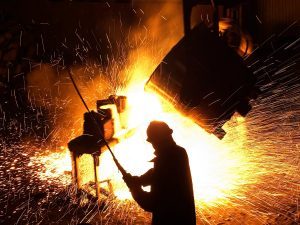 The Metallurgy industry in Kenya has undergone several transformations. It began by manufacturing nails and then gradually branched out into other areas such as wire drawing, galvanizing, hot-rolling, and cold-rolling. These processes require considerable skill, both in production and maintenance. However, the industry has suffered from low indigenous ownership and heavily relies on imported equipment. However, local know-how and skilled manpower have been developing in the sector.
The Metallurgy industry in Kenya has undergone several transformations. It began by manufacturing nails and then gradually branched out into other areas such as wire drawing, galvanizing, hot-rolling, and cold-rolling. These processes require considerable skill, both in production and maintenance. However, the industry has suffered from low indigenous ownership and heavily relies on imported equipment. However, local know-how and skilled manpower have been developing in the sector.
Impact of coronavirus on powder metallurgy market
In the aftermath of the COVID-19 pandemic, automotive and powder metallurgy industries are reeling from an accelerated loss of production and inventory due to the virus. The pandemic has affected the manufacturing sector across the world, with the automotive industry suffering from a 5.1% decline. Other factors affecting the sector include a lack of investment and poor purchasing power. While there are few demands for metal powder in Africa, the recent signing of the African Continental Free Trade Agreement (AFCFTA) will help boost the industry.
The global metallurgy market is projected to witness strong growth in the coming years, driven by the recovery of the aerospace, defense, and construction industries. Increasing competition and technological advancements will also drive demand for metal fabrication supplies and technologies. The healthcare and medical sectors are also expected to boost the market for metal powders.
The rising demand for powder metallurgy will continue to drive the market in the coming years. This technology can be utilized in a variety of industries, including the automotive industry, electrical industry, and the aerospace & defense sector. In addition, the growing popularity of electrical devices and automotive parts will help boost the industry.
Competitive landscape
The metals industry in Kenya is comprised of different sub-sectors including steel smelting, hot rolling, wire products, pipes and cold-rolled steel products. The country’s metal industry is quite old and is dominated by Asian firms. Many of them have extensive links to other African and Asian countries.
Kenya’s manufacturing industry grew rapidly during the early post-independence period. However, since then, it has slowed down, with no drastic shifts in performance. Nevertheless, there were some notable developments during the first half of the 20th century. Kenya’s industrial sector was heavily supported by the government and a policy of import substitution (IS) was introduced. The objective of the IS policy was to ensure basic products would be sold in the domestic market, but the IS policy had other unintended consequences. It led to excess capacity and generalized inefficiency, undermining Kenyan products’ ability to penetrate external markets.
Kenya’s early post-independence industrialization process clustered around three subsectors: textiles, food processing and metals. While the textile industry failed in the 1980s as a result of market liberalization policies, the food processing and metal industries have been relatively stable over the years. However, the country’s economy also has a rapidly growing informal sector, which is low-tech and unorganized.
Development model
Kenya has a strong metalurgical industry that supports both domestic and export demand. As a result, there are a number of investment opportunities in the country. In fact, the market is one of the most dynamic in Africa. However, there are also a number of challenges facing the industry, particularly in terms of access to finance. One such challenge is the lack of skilled labor in the country. This is why it is vital to establish a sustainable supply chain in the country to support local and international demand.
Nevertheless, Kenya’s economy is largely stable, although it faces elevated levels of uncertainty. The country is a net importer of fuel, wheat and fertilizer, which make it vulnerable to global price changes. In addition, it is exposed to the impact of the ongoing conflict in the Ukraine, which has negatively impacted the Kenyan economy.
Powder metallurgy is a method of converting elemental powder into metal. The metal is then compacted and sintered under controlled conditions. This process produces non-ferrous metals and alloys. This method is best suited for simple parts, while it is less effective for complex parts. It is primarily used in bulk manufacturing.
Growth prospects
The metalurgical market in Kenya is expected to expand over the next five years. However, the country’s growth will be hindered by the rapid tightening of global financial conditions and increased prices of fuel and food. Moreover, Kenya is grappling with geopolitical turmoil in neighboring Ethiopia.
As a result, the country is poised to benefit from the growing demand for automobile components. The automotive industry has shown interest in powder metallurgy due to its low cost and durability. Moreover, it helps in the development of highly efficient automotive components while minimizing the amount of material wasted. As a result, many developing countries have started using this technology for the production of automobile components. China, for example, is set to increase its car registrations by over a million in 2020, and is expected to increase by a further one million in 2021.
The market’s growth prospects are largely dependent on the availability of raw materials. In 2018, Kenya produced 1.4 million tons of steel, which is about one-third of the global total. It is forecasted that the global metalurgical market will grow by more than 4% between 2018 and 2027.
